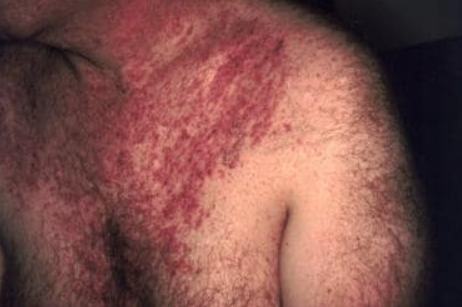Darier disease is a hereditary dermatosis characterized by a disorder of the keratinization process resembling dyskeratosis. ICD-10 Code: Q82.8.
Exact data on the prevalence of Darier disease are not available. The defective gene may be located at 12q23-q24. It is inherited in an autosomal dominant pattern with variable gene penetrance, affecting both males and females.
Darier disease typically develops in childhood or adolescence. The course of the disease is chronic, gradually progressive, with exacerbation during the summer months due to exposure to UV rays.
The clinical manifestations of the dermatosis are characterized by multiple hyperkeratotic, firm papules, usually follicular, 0.2 to 0.5 cm in diameter, spherical in shape with a flat or papillomatous surface covered with scales. The color of the papules ranges from grayish brown to the color of normal skin. When the nodules coalesce, vegetating verrucous lesions with weeping may form in skin folds. The eruptions are typically symmetrical and located predominantly in seborrheic areas (face, scalp, behind the ears, chest, between the shoulder blades, in large folds).
Localized form of Darier disease is characterized by zosteriform or linear distribution of lesions in limited areas.
In vesicular-bullous form, papules coexist with blisters and small vesicles filled with clear fluid, usually located in large folds and on the lateral surfaces of the neck.
Mild diffuse keratoderma or punctate keratosis may be present on the palms and soles.
Dystrophic nail changes are most commonly represented by leukonychia (white or red longitudinal lines). There may also be longitudinal splitting of the nail plate, uneven fracture of the free edge, and subungual hyperkeratosis.
In some patients, the mucous membranes of the oral cavity, larynx, pharynx, esophagus, vulva, vagina, and rectum may be affected, clinically resembling leukoplakia.
The presence of systemic pathology is possible, such as skeletal anomalies, eye involvement, intellectual disability, epilepsy and other mental disorders, as well as dysfunction of endocrine organs.
Disturbances in the cellular immune response have been described, which may contribute to bacterial and viral infections.
- Verruciformis epidermodysplasia (Levandovsky-Lutz)
- Acrokeratosis verruciformis (Hopf)
- Lichen planus
- Hailey-Hailey disease
Treatment is curative and long-term. Liver and kidney function should be monitored before starting retinoid therapy and every 2 weeks during treatment:
- Oral acitretin 10 mg/day for 3-4 weeks, followed by individual maintenance dose (the dose may be increased if the response is insufficient, but not exceeding 25 mg/day; the drug should be used with caution in the vesicular-bullous form) or
- Oral retinyl palmitate 100,000-200,000 IU/day for 2-3 months, 2 courses per year.
Keratolytic agents are used topically:
- Lactic acid, 1-6% ointment, applied topically once daily for 2-3 months (concentration decreases as hyperkeratosis decreases) or
- Urea, 1-10% ointment, applied topically once daily for 2-3 months (concentration decreases as hyperkeratosis decreases) or
- Salicylic acid (or a combination of salicylic acid with sulfur), 2-5% ointment, applied topically once daily for 2-3 months (concentration decreases as hyperkeratosis decreases).
Assessment of treatment efficacy is based on visual inspection of the skin. Visual inspection is performed before starting treatment and every 2 weeks during therapy. The disappearance of skin lesions or a significant reduction in their severity is used as a criterion of treatment efficacy.
Complications and side effects of treatment in children may include hypervitaminosis A, increased cerebrospinal fluid pressure, and hydrocephalus.
Mistakes:
Avoid prescribing retinoids during the summer months. Exceeding the recommended dose of vitamin A and its derivatives (acitretin) and/or using keratolytic agents in increased doses in the presence of blisters should be avoided.
Life expectancy is favorable. Under the influence of treatment, remissions occur, but a complete cure is not achieved.

